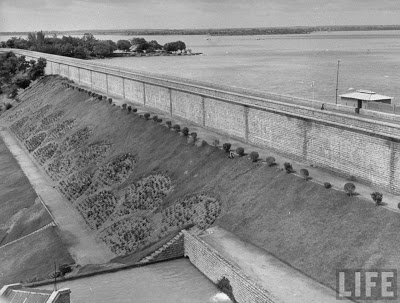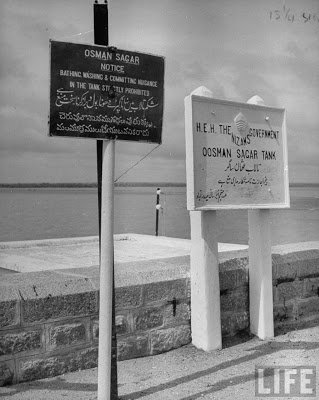One of the most lasting legacies of the Deccan has been the water management policy formulated by the Kakatiya dynasty, which relied mainly on small tanks for its irrigation and drinking water requirements. There was a time when the Telangana countryside boasted of thousands of tanks which ensured a perennial supply of water for settlements across the region. The Qutub Shahi rulers continued the practice by adding numerous tanks of their own, especially in the areas abutting the citadel at Golconda. A majority of those tanks continued to serve the population till post-reorganisation exploitation of the region’s resources led to their being either rendered dry or unusable due to pollution.
Following the great floods of 1908, Mahboob Ali Khan, the then Nizam of Hyderabad, sought long-term and effective solutions to the perennial inundation brought on by a recalcitrant Musi. Initiating the process of ‘improvement’ with a search for the right person to handle the future planning of Hyderabad, the Nizam refused the recommendations of Lord Curzon in offering the services of Sir Michel Esthesol, director general of irrigation, Government of India. Ignoring the availability of T D Mackenzie, chief engineer of the Nizam’s Dominions, he chose the native expert Sir M Visvesvarayya for the job. This was not just a pointed snub at the British, who had already antagonized the Nizam with their unreasonable attitude in dealing with the state, but an informed decision if one takes into account the renowned engineer’s role in influencing policy at the irrigation commission. Visvesvarayya’s ingenious flood control proposal for Hyderabad led to the creation of Osman Sagar and Himayat Sagar, the two ‘balancing tanks’ located upstream of the city. The twin reservoirs, based on the Kakatiya model, served the dual purpose of taming the Musi and at the same time providing an assured water supply to the city.
It is said that 16 villages were submerged to create this sprawling lake, which once spread over 45 square kilometres. The painful displacement of ancient settlements was, however, amply justified by the immediately-apparent benefits of the scheme. Foremost among these was the delivery of safe potable drinking water directly to homes.
Popularly known as Gandipet, Osman Sagar has found a unique place in the hearts of a grateful public, who swear by the curative properties of its waters. It is claimed that the Gandipet waters provide a panacea for almost all known ailments. No wonder then that Gandipet ka Pani, along with the equally notorious Hyderabadi Biryani, has been traditionally blamed for luring visitors into settling down in the city once they acquire a taste for these two cherished commodities.
Understandably, the Nizam Mir Osman Ali Khan remained ever suspicious of Gandipet water, refusing to drink even a single drop from the reservoir named after him! This abhorrence is generally believed to have stemmed from an ingrained preference for the waters of Bam Rukn-ud Dowla, the traditional source of drinking water for Hyderabadi Royalty. The fact that the Nizam never let his personal preferences stand in the way of progress is abundantly manifest in the fact that King Kothi remained unconnected to the state-of-the-art water supply and sewerage network that was commissioned for the city. There is a popular belief that this resolute stand against modernisation arose due to an assurance given by the Nizam to his palace staff that change would not deprive them of their jobs.
Hyderabad was once famous for its gardens and the suburbs of the city were referred to as the ‘Baghaat’ or Garden district. However, by the time of the 1908 floods, most of the historic water bodies in the city and its periphery had been commandeered to cater to the drinking water requirements and minor cultivation needs. The lush gardens of Hyderabad were but a distant memory. With the two major reservoirs providing for the water needs of the city, older water bodies were free to cater to parks and gardens proposed under the city improvement scheme. In certain areas, lakebeds were to be drained and reused as open spaces and parks.
Hyderabad had a City Improvement Board that was working on making the city better and expanding it according to its growth. Funds to the tune of Rs 1 cr was allotted for setting up industries and Sanathnagar was assigned as the hub of industrial activity. When the Nizam transferred power to the Indian Union in 1948, his government offices were functioning from Saifabad Palace, where today’s Secretariat is located. Though the implementation of CIB proposals was abandoned post re-organisation of Hyderabad State, the Hussainsagar continued to irrigate the gardens of Osmania University and downstream localities till industrial effluents rendered it into a cesspool.
The proposal of the Telangana government in favour of protecting lakes is a welcome move and signals a return to the maliciously abandoned schemes of the CIB. Emulating the Kakatiyan legacy bore fruit during the Asaf Jahi period, especially during the reigns of the last two Nizams. Revisiting Visvesvarayya’s proposals and reverting to traditional water management systems will undoubtedly prove to be immensely beneficial for Telangana.
-Sajjad Shahid; Sourced From ToI
 Telangana Talkies | Leading Telangana News, Movies & Entertainment Portal Website with the latest news from Telangana. We present to the world politics, movies, business updates from Telangana & the capital Hyderabad
Telangana Talkies | Leading Telangana News, Movies & Entertainment Portal Website with the latest news from Telangana. We present to the world politics, movies, business updates from Telangana & the capital Hyderabad


